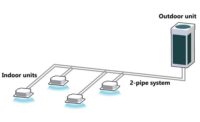Because unit heaters and other non-centralized heating products offer low upfront cost and easy installation, HVAC contractors and building owners commonly use these systems in warehouses; distribution centers; multi-line retail applications; garages; and other large, high-bay facilities. But, these building types often pose unique design considerations that result in increased energy consumption for space heating:
-
Thermal Stratification: Warm air naturally rises and can cause the ceiling air temperature to be 10°-20°F above the thermostat set point. Because of this temperature gradient, the heating system must run longer to meet the needs of the building’s occupants near the floor.
- Loading Dock Door Infiltration: Warehouses use loading docks to receive shipments and load outgoing product, but these are a major source of outdoor air infiltration. This cold air enters the building and pushes displaced warm air toward the ceiling, away from building occupants, increasing heating loads.
To better understand the thermal performance and potential energy savings of a new, direct-fired heating technology, the U.S. Department of Energy (DOE) conducted a field test at a warehouse outside of St. Louis.
Technology Background
In general, direct-fired heating products deliver warm air by combusting natural gas within 100% outside air supply outdoor airstream at a high >90% thermal efficiency. To ensure safety and IAQ, all direct-fired heaters must comply with ANSI Z-83.4, “Non-recirculating Direct Gas-Fired Industrial Air Heaters,” and related standards that limit the output of combustion byproducts to safe levels and specifies gas-ignition, combustion-air, and flame control measures to ensure safe operation. By bringing in 100% outside air, direct-fired equipment does not increase the amount of air entering the building; rather, the airflow brought in by the direct-fired equipment creates a slight positive pressurization and offsets the infiltration that would normally enter through a building’s seams. Through this method, the amount of air entering the building and the related infiltration heat load remains roughly the same while dramatically improving IAQ.
Direct-fired gas heaters supply ventilation and/or space heating airflow to maintain comfortable conditions for building occupants. Common ventilation-only, direct-fired products — called make-up air units — replace exhaust air by conditioning outdoor air only to the desired indoor ambient temperatures and require a separate space heating system to satisfy the conduction heating load of the building. By raising the supply air to a sufficiently high temperature, direct-fired products can also satisfy conduction heating loads in the building.
Demonstration
Bridgeton, Missouri-based Langendorf Supply Co. has supplied HVAC contractors throughout the greater St. Louis region with equipment and materials since 1975. Langendorf’s warehouse includes several aisles of shelving racks that extended to the approximately 24-foot-tall ceilings as well as six loading docks across 42,000 square feet. Although the warehouse’s gas-fired unit heaters operated adequately in past heating seasons, Langendorf looked to reduce its natural gas consumption and improve the comfort of its employees and customers.
The company partnered with nearby manufacturer Cambridge Engineering Inc. to upgrade the warehouse’s space heating system before the 2013-2014 heating season. Cambridge Engineering proposed replacing the standard-efficiency unit heaters with 100% outside air and high discharge temperature, high velocity (HTHV) direct-fired gas heaters with 92% thermal efficiency. The designation HTHV refers to the high discharge temperature of the product that minimizes the required outside airflow to satisfy conduction heating loads and the high velocity of the airflow that generates vertical circulation throughout the building, reducing stratification.
Langendorf and Cambridge Engineering collaborated with the DOE to study the project’s energy savings and performance benefits. To understand site-specific attributes affecting energy consumption, the demonstration study evaluated the new and existing heating equipment during side-by-side operation in alternating months over the 2013–2014 heating season. Monitoring tools collected data on equipment operating hours, temperatures throughout the building, loading dock openings, and other factors. Because the energy consumption of heating equipment depends on outdoor conditions, energy consumption was normalized over the monitoring period according to the number of heating degree days (HDD).
Results
In a side-by-side comparison in alternating months over the 2013–2014 heating season, the new HTHV direct-fired gas heaters demonstrated the following benefits.
Energy Savings (therms, kWh) — The new gas heaters consumed 20% less natural gas than the existing heaters on a normalized basis over the monitoring period. Because the new gas heaters utilize a high-pressure blower to reduce stratification, increased fan electricity consumption offset some of the thermal savings.
Utility Savings ($) — Over an average heating season for the Bridgeton host site (3,705 average HDD–60°F), the new gas heaters would save approximately 15% on space heating utility costs at average utility rates for the site of $0.8/therm and $0.08/kWh.
Performance — As evidenced by the temperature readings near the floor and ceiling, the new gas heaters reduced temperature stratification and maintained more uniform and comfortable temperature setback for additional savings. Ventilation requirements of the building will bring about additional savings.
Next Steps for Purchasers
Contractors serving building owners with high heating bills should consider HTHV direct-fired gas heaters for their customers’ facilities. Nevertheless, the suitability and economics for the technology will vary from site to site due to climate zone, utility rates, temperature set points, installation cost, ceiling height, and other factors. Colder regions will have the highest cost savings potential and shortest payback periods due to the higher number of HDDs they experience each year. Because the high-velocity blower distributes air over a larger area and distributes more heating energy toward the floor, contractors may be able to replace a large number of unit heaters with a smaller number of HTHV gas heaters, further shortening the payback period. If the contractor or building owner can identify the most active heaters by either observation or a monitoring system, such as an advanced thermostat, they could achieve quicker paybacks by replacing heaters with the highest runtimes. Additionally, several gas utilities offer rebates and incentives to lower the incremental cost even further.
For more information on this technology demonstration, please see the full DOE study. The DOE’s Better Buildings Alliance has put together a number of resources including a purchasing specification, payback calculator, demonstration report, case study, and other tools to help contractors, building owners, and purchasers identify and adopt high-efficiency gas heaters.
About the Better Buildings Alliance
The Better Buildings Alliance includes more than 200 members, representing more than 10 billion commercial square feet across seven market sectors: retail, food service, commercial real estate, public, hospitality, health care, and higher education. Together, they catalyze innovation, releasing performance specifications and best practice guidelines for members to deploy.




